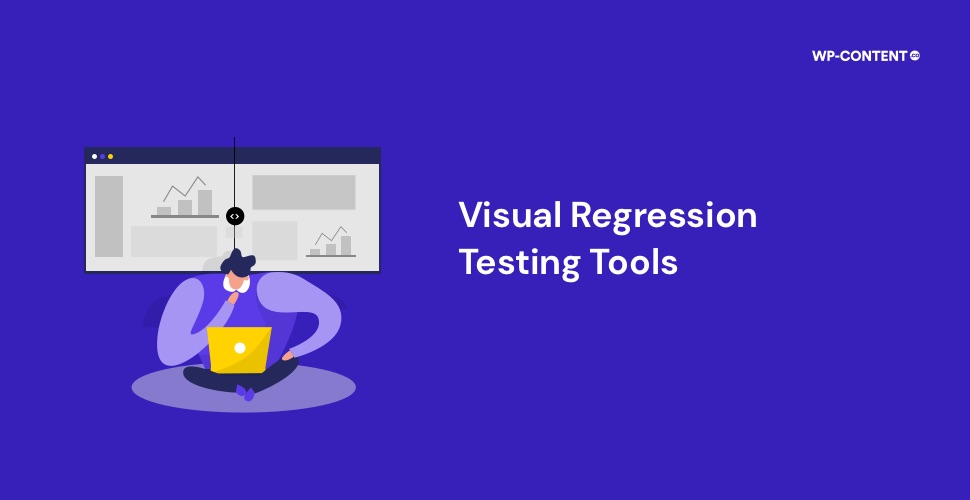When it comes to rolling out new features and changes to your website, taking a bit of time is the best route. This extra bit of time is not just for developing and testing the features but also to ensure it doesn’t disrupt anything else once it goes live.
Every time the website’s code gets updated, there is always a probability of running into unexpected issues. In almost all cases, the recipient will be the GUI of your website. This is where visual regression testing is useful.
In simple terms, visual regression testing means making sure that the front end of your website hasn’t undergone any unwanted changes after an update. It can be anything from misaligned menus and images, font size changes, overlapping text, and so on. The visual regression tools for WordPress will automatically analyze all the pages before and after the new code implementation to make sure that nothing has gone awry.
In the case of WordPress websites, plugins and Core updates can also lead to UI breakdowns. Therefore visual regression tests are important because they will alert you of any UI changes that will lead to a negative user experience.
The Top Visual Regression Testing Tools For WordPress
1. VRTs
VRTs is a complete visual regression tool for WordPress as it covers all the factors that can affect the GUI of your website. Everything from plugin and Core updates, manual code changes, malicious code, server changes, and more.
This plugin will run daily tests for the pages and posts and if any change is detected, the admission will be notified via email. There are three comparison models Difference, Split, and Side-by-Side view. The free version supports testing up to 3 pages, daily testing interval, and 30 days alert history. The premium plan starts at $9/month and supports 25 pages, the ability to test multiple domains, email support, and so on.
Also read: Best A/B Testing Tools For WordPress
2. WP Boom
WP Boom will alert the site admins of any visual difference caused by a plugin, theme, or Core update. With this visual regression tool, there is no need to install a plugin, instead add your website URL to the service and you are good to go. After this, the users need to specify a day for weekly snapshots. After every update, the service will take new snapshots and compare to determine whether any change has occurred or not.
The free plan allows for monitoring two websites and there are 4 premium plans. The premium plans start at $9/month.
3. Percy
Percy is a well-known visual regression testing platform and is now a part of BrowserStack. It is trusted by over 50,000 users and is an excellent way to automate the WordPress visual testing process.
Percy supports a host of integrations making it a breeze to combine it with your projects. Some of the features include pixel-by-pixel diffs, responsive diffs, snapshot stabilizations, seamless status updates to team members, and so on. With Percy, users can test out the website on different browsers and platforms to make sure all users are taken into consideration.
4. Selenium
Selenium is a go-to UI test automation for many and for good reasons. The automation tests can make use of a lot of programming languages that are out there, works with Windows, Mac, and Linux, supports parallel tests, capable of handling dynamic web elements, and also run tests on all the major browsers. It is also open-source.
5. Cypress
Cypress automates the entire end-to-end tests to make sure that the user experience will never be compromised. Users can create test scenarios and automate the entire process. The users can test the apps directly in the browser and also view the debug logs within the browser itself.
Cypress can be integrated with any CI provider and hence can be included in the workflow seamlessly. It has around 5 million plus weekly downloads and over 43k GitHub stars. They have one free plan and three premium plans starting at $67/month.
6. TestComplete
TestComplete is an automated UI testing tool from SmartBear and can be used for all types of applications. This visual regression tool has an AI-powered object recognition engine and can be used for desktop, mobile, and web testing.
The users can also integrate it with various other tools such as Jira, Jenkins, Git, and so on. With this, you can automate the WordPress visual regression tests by building automated UI tests. Other noteworthy features include automated test reporting and analysis, keyword-driven testing, and parallel testing. They offer a free 14-day trial period and the premium plan starts at $1828.
Also read: Free Tools to Test and Analyse Website Performance
7. Katalon
Katalon is built on top of Selenium and Appium and also makes use of AI augmentation for its automated tests. With Katalon setting up and running visual regression tests for WordPress requires only a short amount of time.
The are numerous integration options available and some noteworthy features are self-healing features for automated tests, test failure analysis, on-cloud test environments, layout comparison, and text-to-text comparison.
8. Applitools
Applitools is a popular test automation tool and makes good use of AI to enhance its efficiency and feature set. The users can make use of this service to test almost any web application be it for mobile and desktop. The tool can also analyze PDFs and Docs too.
Applitools is also compatible with over 50 testing frameworks and can also be integrated into various collaboration tools. The cross-browser testing feature is also available. One of the features that makes it a very good visual regression testing tool for WordPress is Applitools Eyes. This feature uses artificial intelligence that allows the service to mimic human eyes to spot visual bugs and other functional drawbacks. Not only that but the tool can separate ads from content and completely ignore them from the testing phase.
Their free plan supports only one user and 100 checkpoints per month. The other three plans are Starter, Eyes, and Ultrafast Test Cloud which offer more features and flexibilities.
9. LamdaTest
LamdaTest is a hugely popular visual regression tool and is used by over 1 million teams and 500+ enterprises. The platform supports testing across 3000+ desktop and mobile environments and makes proper use of artificial intelligence.
The platform can run Selenium as well as Cypress tests and run visual tests on real devices and also supports parallel testing. There is also NPM CLI for StoryBookJS, multiple integration options with CI/CD pipelines, and also a cloud testing platform. The cloud platform bestows the users with automated testing, online browser testing, native app testing, and test at scale.
Their plans are divided into 5 groups and the premium plan starts at $15/ month and also offers one free plan.
10. Screenster
Screenster is an easy-to-use visual regression tool for WordPress that lets you automate test tasks quickly and effortlessly. The UI tests could either be cloud or self-hosted and won’t require you to write any scripts. The users only need to enter the URL of the concerned website and screenster will initiate the process.
Screenster provides self-healing tests, an option for the users to either run the tests on the cloud or run on-prem, parallel test execution, a test scheduler, and many more features. They have a free plan and three premium plans starting at $25/month.
Also read: 3 Methods To Test The Theme Of Your WordPress Website
11. Diffy
As we have mentioned, there are a lot of factors that could break the UI of WordPress websites. One such factor is the updates to the plugins. It doesn’t happen all the time, but there is a chance, and this is where Diffy is useful.
Diffy will compare the website before and after every time a plugin updates to spot unwanted UI changes. This is an excellent visual regression tool for WordPress and also offers a two-week trial period for users to check it out before fully committing to it. Some of the features include daily/weekly monitoring, custom image compare algorithms, multiple integration options, and many more.
12. Playwright
Playwright is a hugely popular open-source framework from Microsoft that has over 51k stars on GitHub. With this users can achieve end-to-end testing effortlessly and also supports cross-browser and cross-platform testing and avoids flaky tests.
The Playwright API is also cross-language compatible. The users can test across Chrome, Firefox, and Webkit with just the Playwright API, and no need to use multiple APIs.
13. WebdriverIO
WebdriverIO is an open-source testing framework for NodeJS. The visual regression testing is achieved with the help of a third-party package called wdio-image-comparison-service. WebdriverIo supports e2e tests along with unit and component testing and also Lighthouse integration.
14. BackstopJS
BackstopJS is an open-source visual regression testing framework that packs in a lot of features. With the recent update, it also supports the Playwright engine. BackstopJS is based on comparing the DOM screenshots to find out the GUI changes.
Other features are in-browser reporting, scenario display filtering, CKI reports, supports screen rendering with Chrome headless, Junit reports, and integrated Docker rendering.
Also read: Firefox Extensions for All Types of WordPress Users
The Importance of Visual Regression Tests and Why You Should Implement It
To keep website visitors hooked on your website, apart from great content, you need to be able to deliver a promising user experience. The website users should be able to find what they are looking for without much hassle. The longer and more tedious the process, the lesser the interaction, which in turn will result in a high bounce rate.
As we have mentioned in the beginning, a lot of factors can influence the user experience negatively under certain circumstances. Be it manual code changes or updates, the chances of it breaking the front end of the website are there. If the font gets changed or the buttons get misaligned, this will result in a negative user experience. With so many pages and elements, checking each one of them manually is not the best way forward. This is where visual regression testing and the tools are useful.
Through automation, these tools will spot visual changes and alert the site admins for further action. The earlier you spot a visual bug and rectify it, the better it is from a user experience standpoint.



